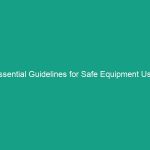Introduction
In the agriculture industry, the importance of health, safety, and Environment (HSE) cannot be overstated. The safe Operation of agricultural machinery is critical not only for the well-being of the operators but also for the efficiency and productivity of farming practices. Agricultural machinery, while essential for modern farming, can pose significant risks if not operated properly. This article aims to provide essential tips for the safe operation of agricultural machinery, ensuring that operators are well-informed about the risks and Best Practices associated with their use.
Understanding Regulatory Frameworks
Before delving into Best Practices, it is crucial to understand the regulatory frameworks that govern the safe operation of agricultural machinery. These Regulations are designed to protect the health and Safety of workers while ensuring compliance with environmental Standards.
Overview of Regulatory Bodies
In many countries, regulatory bodies such as the Occupational Safety and Health Administration (OSHA) in the United States or the Health and Safety Executive (HSE) in the UK oversee safety standards in agriculture. These organizations set guidelines that farmers and machinery operators must adhere to, which include Training requirements, machinery Maintenance standards, and safety operational Procedures.
Key Regulations to Consider
Some of the key regulations that pertain to the safe operation of agricultural machinery include:
- Training Requirements: Operators must receive proper training on the equipment they will be using. This includes understanding the machinery’s controls, safety features, and emergency procedures.
- Maintenance Standards: Regular maintenance and inspections are mandated to ensure machinery is in safe working condition.
- Personal Protective Equipment (PPE): Regulations often require the use of PPE, such as helmets, gloves, and Eye Protection, to minimize injury risks.
Importance of Compliance
Compliance with these regulations is essential not just for legal reasons, but also for fostering a culture of safety within the agricultural sector. By adhering to established guidelines, operators can significantly reduce the risk of accidents and injuries, making the workplace safer for everyone involved.
Best Practices for Safe Operation
Implementing best practices is vital for the safe operation of agricultural machinery. These practices not only enhance safety but also improve overall operational efficiency.
Conducting Pre-Operation Inspections
Before operating any agricultural machinery, a thorough pre-operation inspection should be conducted. This includes checking for:
- Fluid leaks
- Brake functionality
- Steering and control systems
- Safety guards and shields
A checklist can be an effective tool to ensure that all necessary checks are performed systematically. This proactive approach helps to identify potential issues before they lead to accidents.
Utilizing Proper Techniques
In addition to inspections, employing proper operational techniques is crucial. Operators should be trained to:
- Maintain a safe distance from other workers and machinery
- Be aware of their surroundings, including obstacles and bystanders
- Use hand signals or radios for communication when working in teams
By utilizing these techniques, operators can significantly reduce the likelihood of accidents during machinery operation.
Implementing Safe Work Practices
Establishing safe work practices is fundamental for the safe operation of agricultural machinery. This includes:
- Creating a designated work area free of Hazards
- Adopting a “no running” policy around machinery to prevent accidents
- Ensuring all machinery is equipped with appropriate safety features, such as roll-over protection structures (ROPS)
By implementing these practices, operators can create a safer work environment that minimizes risks associated with machinery operation.
Case Studies of Safe Operation in Agriculture
Real-world case studies can provide valuable insights into the importance of safe operation of agricultural machinery. Analyzing these cases allows us to learn from both successes and failures.
Case Study 1: Successful Implementation of Safety Practices
A mid-sized farm in Ohio implemented a comprehensive training program for its operators, focusing on the safe operation of agricultural machinery. The program included hands-on training, safety drills, and regular safety meetings. As a result, the farm reported a 60% decrease in machinery-related accidents over two years. This case highlights how investing in training and safety can lead to significant improvements in Workplace Safety.
Case Study 2: Consequences of Neglecting Safety
In contrast, a farming operation in California faced legal repercussions following a serious accident caused by inadequate Safety Measures. The operator was not trained on proper machinery use, resulting in injuries to both the operator and a bystander. This incident underscores the importance of adhering to safety regulations and implementing best practices to prevent accidents and protect individuals.
Challenges to Safe Operation
Despite the established practices and regulations, several challenges persist in ensuring the safe operation of agricultural machinery. Understanding these challenges is key to developing effective solutions.
Workforce Training and Education
One of the significant challenges is ensuring that all operators receive adequate training. Many agricultural workers may not have formal education or training in machinery operation, leading to unsafe practices. Moreover, language barriers can hinder effective communication during training sessions. Therefore, providing accessible training resources and materials in multiple languages is crucial to overcoming this barrier.
Machinery Maintenance and Repair
Another challenge is maintaining agricultural machinery in optimal working condition. Budget constraints may prevent farmers from conducting regular maintenance or investing in new equipment. As a result, older machinery may be used longer than recommended, increasing the risk of mechanical failure. Implementing a scheduled maintenance program can help mitigate this risk, ensuring that machinery is regularly inspected and repaired.
Rapid Technological Changes
The agricultural sector is rapidly evolving with advancements in technology. While this can enhance productivity, it also requires continuous operator education to keep up with new machinery and safety features. Farmers must prioritize ongoing training to ensure that operators are familiar with the latest equipment and safety protocols. This can be achieved through workshops, online courses, and hands-on demonstrations.
Future Trends in Agricultural Safety
As the agricultural industry continues to evolve, so too will the practices and technologies associated with the safe operation of agricultural machinery. Staying informed about future trends is essential for ensuring ongoing safety improvements.
Increased Use of Automation
One of the most significant trends is the increased use of automation in agriculture. Automated machinery can reduce the need for manual labor and minimize human error, leading to a safer work environment. However, operators will need training on how to interact with and monitor these automated systems effectively.
Integration of Smart Technology
Smart technology, such as sensors and GPS tracking, is becoming more prevalent in agricultural machinery. These technologies can enhance safety by providing real-time data on machinery performance and operator behavior. Implementing smart technology can lead to proactive maintenance and improved safety protocols.
Focus on Mental Health and Well-being
There is also a growing recognition of the importance of mental health in the agricultural workforce. Stress and mental health issues can impact an operator’s ability to focus and operate machinery safely. Programs that promote mental well-being, such as stress management workshops and support networks, will become increasingly important in ensuring the safe operation of agricultural machinery.
Conclusion
In conclusion, the safe operation of agricultural machinery is a multifaceted issue that requires a comprehensive approach involving training, maintenance, adherence to regulations, and an understanding of emerging trends. By implementing best practices and addressing challenges head-on, farmers and operators can create a safer work environment that protects individuals and enhances productivity. We encourage all stakeholders in the agricultural sector to prioritize HSE practices and invest in the safety and well-being of their workforce. Remember, a safe operation is not just a legal obligation—it’s a moral responsibility that ensures the future of agriculture.


